The New England Varve Chronology Today
Since the time of Antevs (1922, 1928) there have been several additions and small revisions to the New England Varve Chronology (NEVC). An important part of updates has been the matching of new varve sections to Antevs� original NEVC, which adds to the documented reproducibility of the varve sequences. Only sections added to the NEVC up to 2008 are shown on the profiles below. For the most updated compilation of varves in the northeastern U.S. go to North American Varve Chronology. The approximate geographic locations and relative ages of different varve series in Antevs� NEVC are shown on the map below. The green bars (NE 2701-6352) in the Connecticut, Merrimack, Hudson, and Ashuelot valleys represent the older part of the NEVC, also called the lower Connecticut varves. The purple bars (NE 6601-7750) in the Connecticut and Winooski valleys represent the younger part of the NEVC, also called the upper Connecticut varves. The varve series are separated by the Claremont Gap of arbitrary length (NE 6353-6600) as interpreted by Antevs (1922). The map also serves as a key to detailed time-distance plots of all of the known varve sections that were either part of Antevs� original compilation or have been matched to the NEVC in the Connecticut and Merrimack valleys. The plots show the time spans of individual varve sections plotted along the axis of the various valleys in the direction of ice recession. By placing your cursor in the red boxes you can view the detailed plots for each valley section including separate areas in: Connecticut, Massachusetts, southern Vt./N.H., central Vt./N.H., and northern Vt./N.H. in the Connecticut Valley. Also shown are sections in the Hudson Valley near Catskill and Newburgh, NY, the Merrimack Valley, and the Winooski Valley. The Ashuelot valley near Keene, NH has not been plotted because it is represented by only one section.
- Data files for Antevs' original normal curves of the NEVC are available for download through this link.
- Data files for most new varve sections that have been matched to the NEVC as well as many other varve records in the northeastern U.S. are available for download through this link.
Use the map to locate the varve stratigraphy for a particular area by clicking in areas outlined in red. You may click on a tab heading to open the corresponding varve record as well. This page is best viewed at 1024x768 pixels and above.
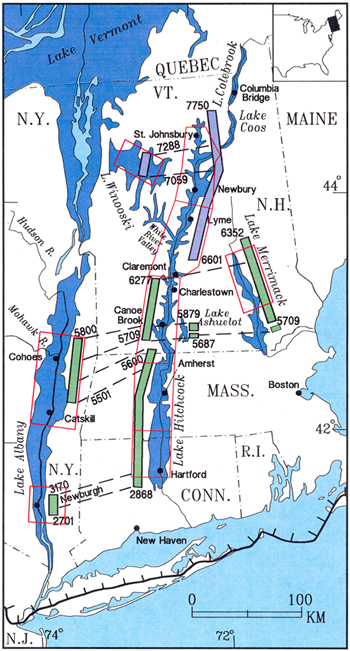
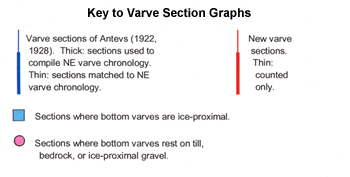
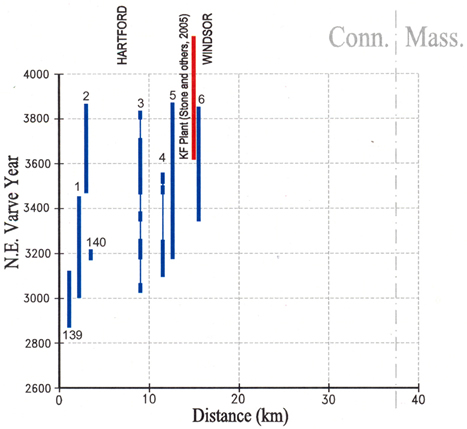
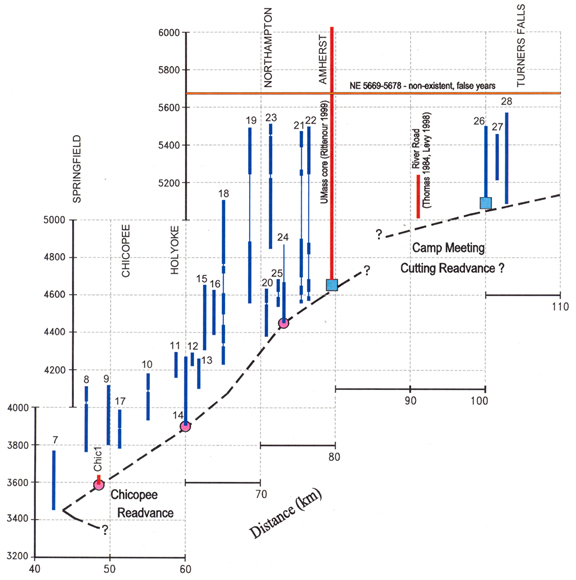
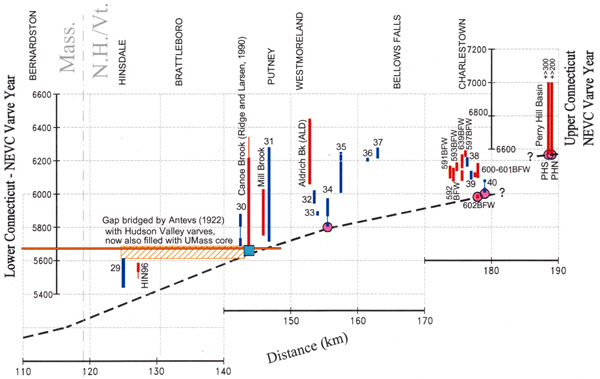
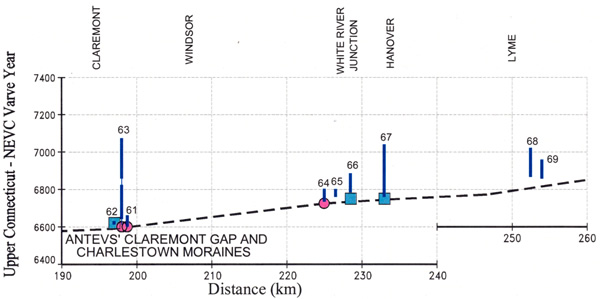
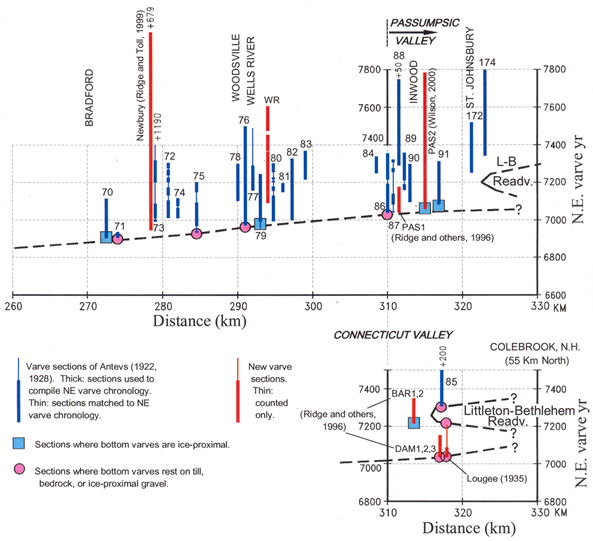
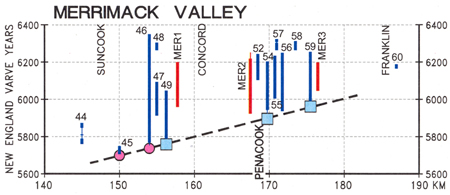
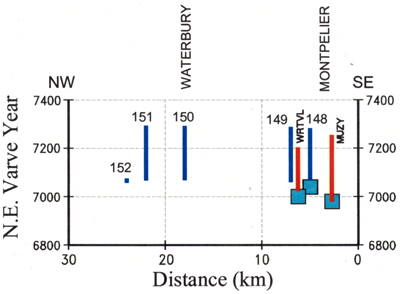
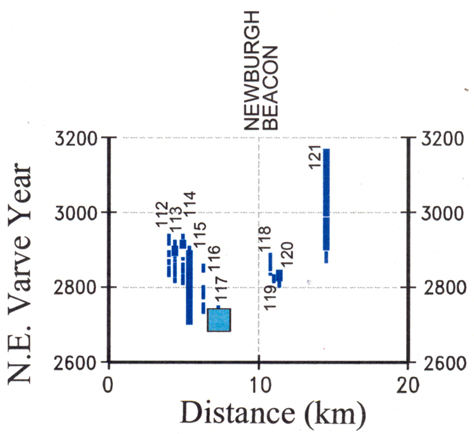

Map and Section Key
- All numbered sections in dark blue on the diagram are the original sections measured by Antevs to compile the NEVC (1-91 and A-J from Antevs, 1922; 112-121, 139-140, 148-152, and 172 and 174 from Antevs, 1928). Data for these sections are available through this link.
- All sections in red have been matched to the NEVC by later workers. Red section sites in the Merrimack Valley are in Ridge and others (2001). Sites in the Connecticut Valley without references were compiled at Tufts University and have not yet been published. Data for these sections are available through this link.
- Pink circles are sections where the bottom of the measured varves rest on till, bedrock, or ice-proximal sand and gravel.
- Light blue squares mark sections where the bottom measured varves are thick and sandy ice-proximal varves interpreted to be deposited within a century of deglaciation.
- The dashed line across the bottom of some sections represents the interpreted maximum age of varves or the age of deglaciation.
- Also shown are some gaps and corrections on the Connecticut Valley plots. Most notable is a gap in Connecticut Valley sequences bridged by an overlapping varve sequence in the Hudson Valley measured by Gerard De Geer (Antevs, 1922). This gap has since been filled with Connecticut Valley varve measurements in the UMass core at Amherst (Rittenour, 1999). The UMass core revealed an error (�false varves�) in the Hudson Valley sections near Catskill, NY as described below.
Error in the Original Hudson Valley Record
The UMass core in the Connecticut Valley has revealed an error in the Hudson Valley record of the NEVC. Exceptionally thick couplets interpreted by De Geer to be varves in the Hudson Valley (NE 5669-5678) are missing from duplicate cores at the UMass core site. The Hudson Valley couplets are thought to be inter-annual flood events (Rittenour, 1999) produced by the drainage of a lake in the Mohawk Valley into the Hudson Valley. These flood units are no longer considered annual layers but instead beds formed by repeated Mohawk Valley water release and floods during the course of a single summer.
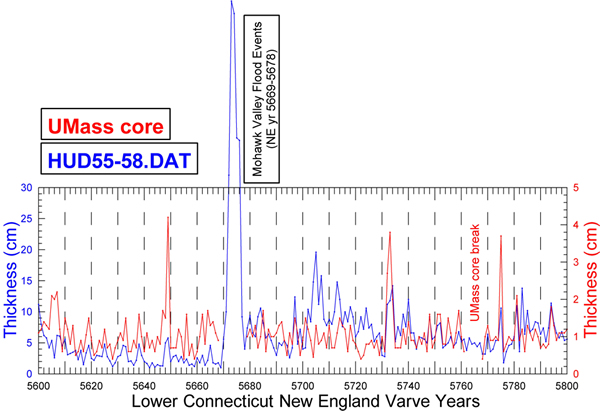
Plot of the UMass core (red; Rittenour, 1999) with its correlation to the Hudson Valley record of De Geer (blue) as reported in Antevs (1922). Varves NE 5669-5678 do not appear in the UMass cores with no apparent erosion. On the plot, varves NE 5600-5667 and 5724-5800 match very well while varves immediately after the flood events in the Hudson Valley record (NE 5679-5723) are noticeably thicker than varves prior to the flood and do not match any other regional record. Increased thickness and deposition that is not controlled by a regional glacial meltwater signal may be related to deposition immediately after the large flood events.
References
- Antevs, E., 1922, The Recession of the Last Ice Sheet in New England: American Geographical Society Research Series, no. 11, 120 p.
- Antevs, E., 1928, The Last Glaciation with Special Reference to the Ice Sheet in North America: American Geographical Society Research Series, no. 17, 292 p.
- Levy, L.B., 1998, Interpreting the carbonate concretions of glacial Lake Hitchcock: Unpublished B.A. Thesis, Mount Holyoke College, Mount Holyoke, Massachusetts, 126 p.
- Lougee, R.J., 1935b. Time measurements of an ice readvance at Littleton, N.H. Proceedings of the National Academy of Sciences 21, 36-41.
- Ridge, J.C., Larsen, F.D., 1990, Re-evaluation of Antevs� New England Varve Chronology and new radiocarbon dates of sediments from glacial Lake Hitchcock: Geological Society of America Bulletin, v. 102, p. 889-899.
- Ridge, J.C., Toll, N.J., 1999, Are late-glacial climate oscillations recorded in varves of the upper Connecticut Valley, northeastern United States?: Geologiska Foreningens i Stockholm F�rhandlingar 121(3), p. 187-193.
- Ridge, J.C., Thompson, W.B., Brochu, M., Brown, S., Fowler, B., 1996, Glacial geology of the upper Connecticut Valley in the vicinity of the lower Ammonoosuc and Passumpsic Valleys of New Hampshire and Vermont, in Van Baalen, M.R. (Ed.), Guidebook to Field Trips in Northern New Hampshire and Adjacent Regions of Maine and Vermont: 88th Annual Meeting, New England Intercollegiate Geological Conference, Harvard University, Cambridge, Massachusetts, pp. 309-340.
- Ridge, J.C., Canwell, B.A., Kelly, M.A., and Kelley, S.Z., 2001, An atmospheric 14C chronology for Late Wisconsinan deglaciation and sea level change in eastern New England using varve and paleomagnetic records: in Weddle, T. and Retelle, M., Deglacial History and Relative Sea-level Changes, Northern New England and Adjacent Canada: Geological Society of America Special Paper no. 351, p. 171-189.
- Rittenour, T.M., 1999, Drainage history of glacial Lake Hitchcock, northeastern USA: Unpublished M.S. Thesis, Univ. of Massachusetts, Amherst, 179 p.
- Stone, J.R., Stone, B.D., DiGiacomo-Cohen, M.L., Lewis, R.S., Ridge, J.C., and Benner, J.S., 2005, The new Quaternary geologic map of Connecticut and Long Island Sound Basin; Part 2 � Illustrated by a fieldtrip in the Connecticut River Valley, in Skinner, B.J. and Philpotts, A.R., eds., Guidebook for Field Trips in Connecticut: 97th Annual Meeting, New England Intercollegiate Geological Conference, Yale University, New Haven, Connecticut, Trip B2, p. 131-159.
- Thomas, G.M., 1984, A comparison of the paleomagnetic character of some varves and tills from the Connecticut Valley: Unpublished M.S. Thesis, Univ. of Massachusetts, Amherst, 136 p.
- Wilson, B.R., 2000, A chronology and environmental interpretation of glacial to non-glacial lacustrine varves in the Passumpsic Valley, Barnet, Vermont: Unpublished B.S. Thesis, Tufts University, Medford, Massachusetts, 83 p.


